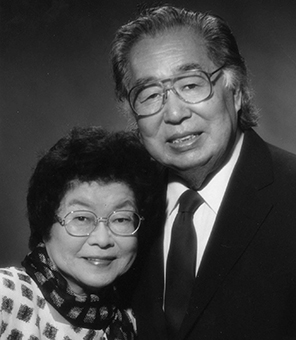Page Title
Tomoye Takahashi: From Imprisonment to a Life of Giving
 After four years in a U.S. concentration camp during World War II, Tomoye Takahashi and her husband Henri supported many of the city’s institutions—including UCSF’s Osher Center for Integrative Medicine. |
Tomoye Takahashi lived a full and remarkable life, triumphing over the hardship of spending four years in a U.S. concentration camp during World War II. She and her husband Henri not only started their family there, they returned to San Francisco to build a prosperous business, become thoughtful philanthropists, and spend their lives serving as ambassadors for Japanese culture.
“My parents dedicated their lives to educating the public about the quality and aesthetic aspects of Japanese culture,” says their daughter Masako, who, with her brother Norman, was born at the Central Utah War Relocation Center in Topaz during her parents’ internment. “By bringing beautiful crafts to the U.S. to sell in places like Gump’s, my parents transformed the meaning of the phrase Made in Japan.”
Henri passed away in 2002, and Tomoye died in 2016—just shy of her 101st birthday—leaving the bulk of their estate to charity. Among her bequests was a $1 million gift to the UCSF Osher Center for Integrative Medicine to establish the Tomoye Takahashi Fund for Research in Integrative Medicine. The fund will support research on mindfulness, acupuncture, and other alternative medicine approaches to learn more about their effectiveness and mechanisms of action.
“Mrs. Takahashi has been one of our major champions, and we are so grateful for her gifts,” says Osher Center Director Shelley Adler, PhD. “She had a deep understanding and appreciation for Japanese contributions to our culture and their effect on well-being.” Tomoye also funded the Takahashi Garden, a Japanese healing garden at the center.
Born on Stanyan Street of Japanese parents, Tomoye earned her bachelor’s degree in decorative arts from UC Berkeley. She married Henri shortly before the Japanese attack on Pearl Harbor precipitated their removal to the camps, along with 120,000 others of Japanese descent. After the war, the Takahashis returned to San Francisco and opened a dry goods store on Post Street in Japantown. They exported medicines, clothing, and other staples to war-torn Japan and soon began importing traditional items, like folk pottery, lacquerware, and musical instruments.
By the 1960s they were creating contemporary designs with traditional Japanese materials, like the shoji screen, an entirely original design. From the single store, the business grew to several in and around San Francisco and one in New York City. Many of their creations were selected for the definitive Good Design Exhibition at New York City’s Museum of Modern Art in 1950.
In 1985 the Takahashis established the Henri and Tomoye Charitable Foundation, helping support the Asian Art Museum, the Japanese American Cultural Center of Northern California, documentary films on Japanese-American history, and other efforts. In 2010 Tomoye was awarded the prestigious Order of the Rising Sun, Gold and Silver Rays, by the government of Japan to acknowledge her lifetime of cultural service.
Tomoye remained steadfast in her loyalties: to UC Berkeley, where she kept up her team spirit by rooting for Cal; to San Francisco, where she lived nearly her entire life; and, despite her incarceration, to the United States.
© Pentera, Inc. Planned giving content. All rights reserved.
Your giving creates a lasting legacy.
Make a Planned Gift